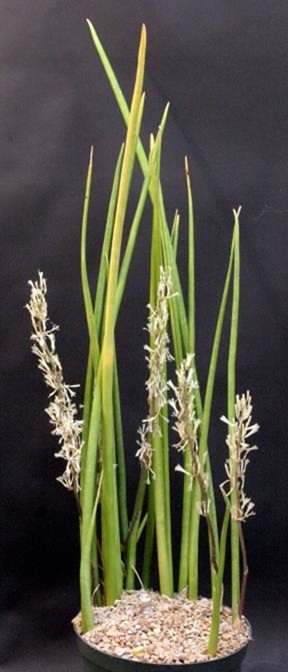| |
Sansevieria bacularis Pfennig ex A. Butler & Jankalski |
| Protologue: |
Sansevieria 22: 3-9 (2010). |
| Subgenus: |
Sansevieria |
| Group: |
Sansevieria canaliculata |
| Etymology: |
The epithet means “rod or staff,” referring to the long, cylindrical leaves. |
| Distribution: |
Democratic Republic of the Congo. |
| Brief Description: |
An acaulescent and rhizomatous species, it has 1 – 2 rod-like leaves that are usually upright, cylindrical, and bearing a soft tip. The leaves are 125-170 cm in height by 1.1-1.5 cm in diameter, have a yellow-green color, and the base transitions upward to a darker green with lighter-colored banding. The leaves may be smooth or slightly rough, and the base typically has a small, deep purple bract. The inflorescence is 115 cm tall and simple with 2 – 8 flowers per cluster. |
| Similar Species: |
This species is in what could be called the “javelin-plant’ group that includes Sansevieria cylindrica, Sansevieria stuckyi, S. fischeri, S. canaliculata, and S. pfennigii. However, Sansevieria bacularis, S. canaliculata, and S. pfennigii are in subgenus Sansevieria whereas the others are in subgenus Capitulatus. Sansevieria bacularis, once known as S. sulcata, cannot be confused with any of these species owing to the length, color, and thin diameter of its leaves and their lack of channels. |
| |
| |

Sansevieria bacularis flowering in cultivation.
|
|
| |
| |
|
|
| |
| |
|
|

